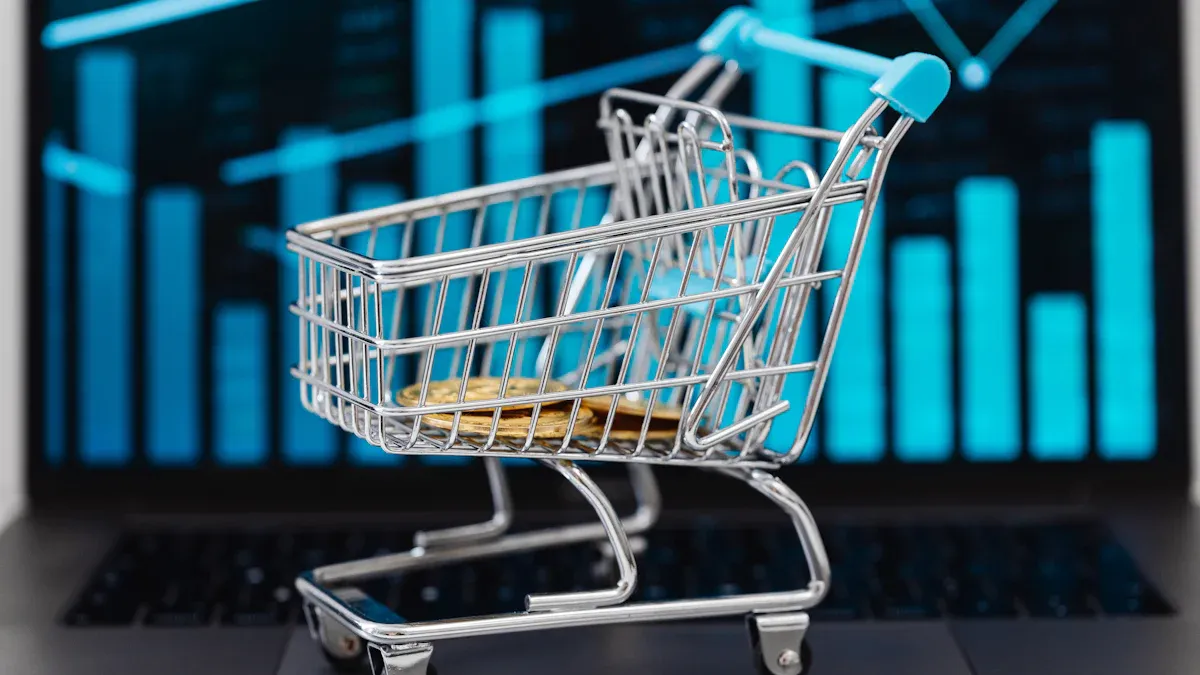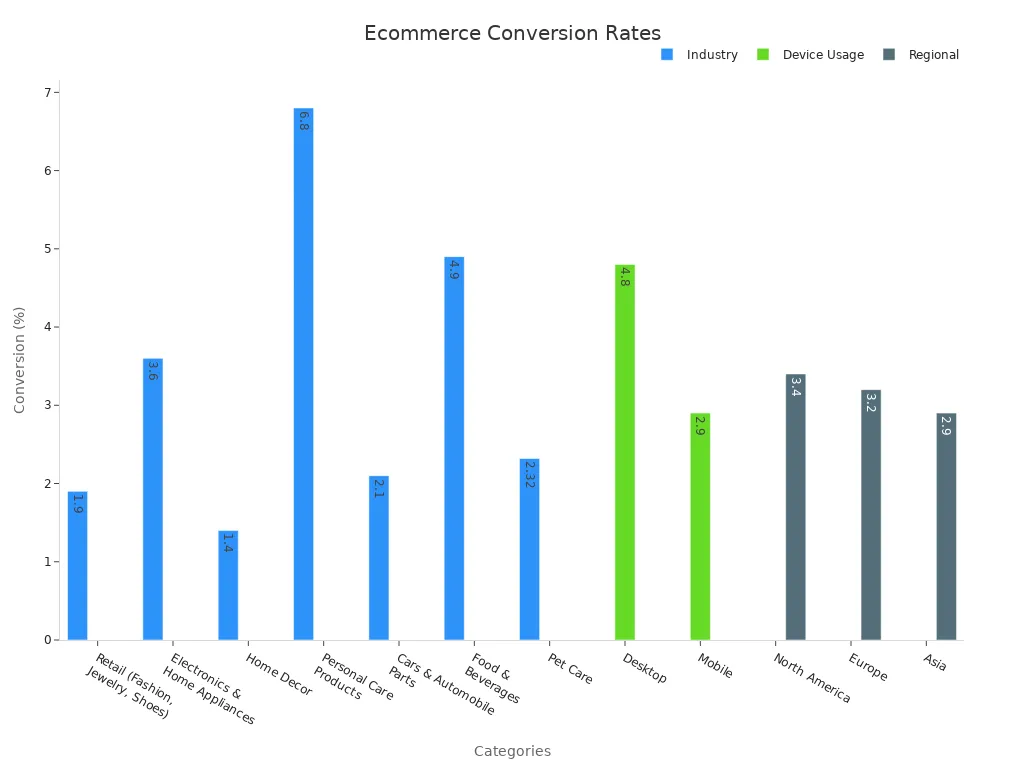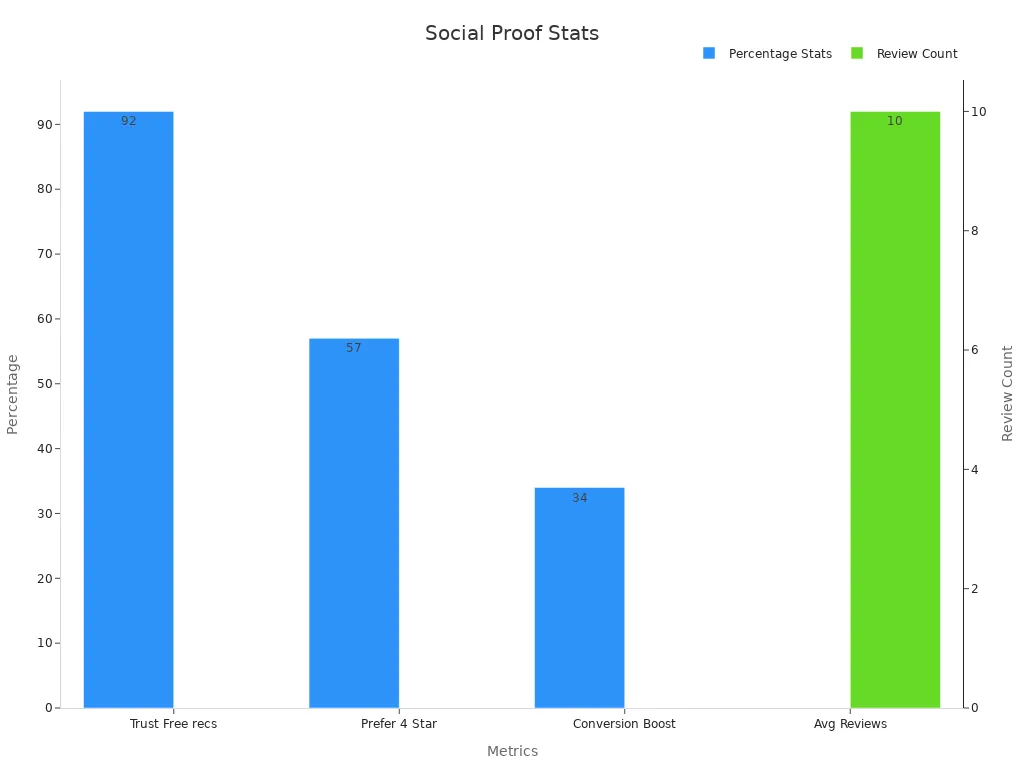Secrets to Achieving Better Ecommerce Conversions

Ecommerce has transformed how businesses connect with customers. Ecommerce conversion rates play a crucial role in determining success on an ecommerce website. Higher rates mean more visitors turn into buyers, boosting revenue and growth.
According to Millward Brown Digital, Amazon Prime users converted 74% of the time, compared to 3.32% for non-Prime users. This highlights how impactful conversion rates can be for business success.
In 2025, ecommerce faces new challenges. Mobile-first shopping, personalized experiences, and faster technologies demand innovative strategies. A conversion rate above 3.2% places your store among the top 20%, while rates above 4.8% show exceptional performance. With tools like Sobot, businesses can enhance their ecommerce conversion and stay ahead in this competitive environment.
Understanding Ecommerce Conversion Rates
What is an Ecommerce Conversion Rate?
An ecommerce conversion rate measures how effectively your website turns visitors into paying customers. It’s a critical metric that reflects the success of your online store.
To calculate it:
- Divide the total number of conversions (sales) by the total number of visitors.
- Multiply the result by 100.
For example, if your site receives 500 visitors and generates 100 sales, the ecommerce conversion rate is:
100 ÷ 500 × 100 = 20%.
Google Analytics defines this rate as the ratio of transactions to sessions, expressed as a percentage. Factors like product type, visitor behavior, and device usage can influence this metric. Tracking these details helps you understand your audience better and refine your strategies.
Why Ecommerce Conversion Rates Matter
Ecommerce conversion rates directly impact your revenue and growth. A higher rate means more visitors are completing purchases, which translates to increased sales.
A recent study highlights the importance of managing customer reviews to optimize conversions. It found that while reviews boost trust and encourage purchases, an excessive number can overwhelm potential buyers. This underscores the need for balance in your approach.
Conversion rates also reveal how well your website meets customer expectations. A low rate might indicate issues like poor navigation, slow load times, or unclear product descriptions. Addressing these problems can significantly improve your performance.
Benchmarks for Ecommerce Conversion Rates in 2025
Understanding industry benchmarks helps you set realistic goals. In 2025, average ecommerce conversion rates vary by industry, device, and region.
| Industry | Average Conversion Rate |
|---|---|
| Retail (Fashion, Jewelry, Shoes) | 1.9% |
| Electronics & Home Appliances | 3.6% |
| Personal Care Products | 6.8% |
| Food & Beverages | 4.9% |
Device usage also plays a role:
- Desktop: 4.8%
- Mobile: 2.9%
Regional variations show North America leading with a 3.4% average, followed by Europe at 3.2%.

These benchmarks provide a clear picture of where your business stands and what you can aim for in the competitive ecommerce landscape.
Optimizing User Experience for Higher Conversion Rates

Mobile Optimization Strategies
Mobile devices dominate the ecommerce landscape, accounting for 67% of all sales. To increase conversion rates, you must prioritize mobile optimization. Mobile-optimized product pages convert 102% better than desktop pages viewed on mobile browsers. This highlights the importance of designing your site with mobile users in mind.
Start by ensuring your website is responsive. A responsive design adapts seamlessly to different screen sizes, providing a consistent experience across devices. Mobile apps also offer a significant advantage. They boast a 3.5% conversion rate compared to 2% for mobile websites and have a cart abandonment rate of just 20%, far lower than desktop's 68%. Additionally, users engage with 4.2 times more products per session in mobile apps than on mobile websites.
Walmart's responsive redesign serves as a prime example of mobile optimization success. The company achieved a 20% overall conversion boost, with mobile orders increasing by an impressive 98%. By focusing on mobile-first strategies, you can boost ecommerce conversion rates and stay competitive in a mobile-driven market.
Simplifying Navigation and Search
A cluttered website can overwhelm visitors and drive them away. Simplifying navigation and search enhances user engagement and helps increase conversion rates. Intuitive navigation allows customers to explore your site effortlessly, while logical information architecture organizes products in a way that resonates with users.
To simplify navigation, use a clean menu structure. Avoid overloading it with too many categories. Advanced search functionality is equally important. Features like autocomplete and filters enable users to find specific products quickly, reducing cognitive load and improving their shopping experience. A prominently placed search bar is essential for users who prefer searching over browsing.
Simplified navigation also reduces bounce rates and cart abandonment. It increases product discoverability, leading to sales from items that might otherwise go unnoticed. Performance metrics like bounce rate, time on site, and product views can help you measure the impact of these improvements. By streamlining navigation and search, you create an enhanced user experience that drives conversions.
Enhancing Page Load Speeds
Page load speed is a critical factor in ecommerce conversion optimization. A delay of just one second can decrease conversion rates by 7%. If your page takes over three seconds to load, 53% of mobile users will abandon it. These statistics underscore the importance of optimizing load times to increase conversion rates.
To enhance page load speeds, start by compressing images and using a content delivery network (CDN). Minimize the use of heavy scripts and ensure your hosting service can handle high traffic volumes. A study monitoring over 245,000 site visits found that users with a load time of three seconds or less visited 60% more pages. Faster load times not only improve user engagement but also directly impact your bottom line.
Deloitte's research with Google revealed that a 0.1-second improvement in load time can lead to an 8.4% increase in conversions. Rakuten 24 experienced a 33.13% boost in conversion rates after optimizing their Core Web Vitals. By prioritizing speed, you can create a seamless shopping experience that encourages users to complete their purchases.
Leveraging Social Proof to Increase Conversion Rates
The Role of Customer Reviews and Testimonials
Customer reviews and testimonials act as powerful social proof, influencing purchasing decisions and building trust. Shoppers often rely on reviews to validate their choices. On average, buyers read 10 reviews before making a purchase. Additionally, 92% of consumers trust non-paid recommendations over paid advertisements. Displaying testimonials can increase conversion rates by 34%, making them a critical component of your ecommerce strategy.
| Statistic | Value |
|---|---|
| Average number of online reviews read before purchase | 10 reviews |
| Likelihood of trusting non-paid recommendations over paid ads | 92% |
| Percentage of buyers who prefer brands with at least a 4-star rating | 57% |
| Increase in conversion rate from displaying testimonials | 34% |

By showcasing reviews prominently on your website, you can enhance credibility and encourage more purchases.
Using Influencer Marketing Effectively
Influencer marketing has become a cornerstone for ecommerce brands aiming to boost visibility and conversions. Over half of ecommerce businesses use influencers to reach targeted demographics. Influencers provide authentic endorsements, which resonate with their followers. Studies show that 84.8% of brands find influencer marketing effective, with 36% reporting that influencer-generated content outperforms branded content.
| Evidence Type | Description |
|---|---|
| Influencer Marketing Value | Over half of eCommerce brands use influencer marketing to boost sales, brand visibility, and customer loyalty. |
| Performance Comparison | 36% of brands report that influencer content outperforms branded content. |
| Effectiveness | 84.8% of brands find influencer marketing effective. |
Collaborating with influencers who align with your brand values can amplify your message and drive ecommerce conversion.
Trust Signals: Badges, Certifications, and More
Trust signals reduce perceived risk and reassure customers about the security of their transactions. Features like SSL certificates, third-party endorsements, and policy-specific badges play a vital role in shaping customer behavior. For example, trust badges at checkout increase confidence, while shipping and return policy badges enhance transparency.
- Trust badges convey security at a glance, including:
- SSL certificates
- Third-party endorsements
- Policy-specific badges clarify:
- Shipping policies
- Return policies
- Security badges at checkout boost confidence.
With 86% of shoppers valuing five-star ratings and positive reviews, trust signals are essential for building credibility and increasing conversions.
Streamlining Checkout Processes for Ecommerce Conversion Optimization

One-Click Checkout Solutions
Simplifying the checkout process is one of the most effective ways to increase conversion rates. One-click checkout solutions allow customers to complete their purchases with minimal effort. By reducing the number of steps required, you can eliminate friction and improve the overall shopping experience.
Amazon’s one-click checkout feature is a prime example of how this strategy can boost ecommerce conversion rates. It saves customers time and reduces the likelihood of cart abandonment. Implementing similar solutions on your ecommerce platform can streamline the process and encourage repeat purchases. Tools that securely store payment and shipping information make this possible, ensuring convenience without compromising security.
Offering Multiple Payment Options
Providing diverse payment options is essential for ecommerce conversion optimization. Customers have different preferences when it comes to payment methods. Some prefer traditional options like credit cards, while others favor modern alternatives such as PayPal or Apple Pay. Offering these choices can significantly increase conversion rates by catering to a wider audience.
- Include popular payment methods like credit cards, PayPal, and Apple Pay.
- Mobile wallets appeal to younger consumers due to their convenience.
- Instant financing options allow customers to spread payments over time, enabling larger purchases.
- Accepting cryptocurrencies attracts customers interested in digital currencies.
By accommodating these preferences, you reduce cart abandonment and optimize shopping cart and checkout experiences. Providing alternative payment methods ensures customers can complete their purchases without unnecessary hurdles.
Transparent Pricing and Shipping Information
Transparency in pricing and shipping details builds trust and reduces cart abandonment. Customers want to know the total cost of their purchase, including shipping fees, before reaching the checkout page. Hidden costs or unclear delivery timelines often lead to frustration and drop-offs.
- Display accurate shipping costs and delivery dates early in the buying journey.
- Offer free shipping to incentivize higher order values.
- Provide multiple shipping options, including in-store or curbside pickup, to enhance convenience.
Clear pricing and shipping information create a seamless checkout experience. When customers feel confident about what they’re paying and when they’ll receive their items, they’re more likely to complete their purchases. This approach not only boosts conversion rates but also fosters customer loyalty.

Personalization and Engagement with Sobot Live Chat
Personalization has become a cornerstone of ecommerce conversion optimization. Customers now expect tailored interactions that cater to their unique preferences and behaviors. Sobot Live Chat empowers businesses to deliver these personalized experiences, enhancing customer satisfaction and driving conversions.
AI-Powered Product Recommendations
AI-powered product recommendations are a game-changer for ecommerce. By analyzing customer data, AI identifies patterns and preferences to suggest products that align with individual interests. This approach not only improves the shopping experience but also boosts sales.
| Metric Type | Description |
|---|---|
| Incremental Revenue | Revenue generated directly from recommendation clicks, indicating the sales value of recommended items. |
| Average Order Value (AOV) Impact | Comparison of AOV with and without recommendations, showing how recommendations encourage additional purchases. |
| Conversion Rate Impact | Changes in conversion rates based on different recommendation strategies, linking them to overall sales performance. |
Sobot Live Chat integrates AI-driven predictive analytics to provide personalized product suggestions in real time. For example, if a customer browses a specific category, the system can recommend complementary items, increasing the likelihood of purchase. Businesses like HP Tronic have reported significant increases in conversions due to AI-powered recommendations. With Sobot, you can leverage this technology to increase conversion rates and enhance customer engagement.
Real-Time Customer Support with Live Chat
Real-time customer support is essential for reducing cart abandonment and improving ecommerce conversion. Sobot Live Chat enables businesses to provide instant assistance, addressing customer concerns before they leave the site.
| Statistic | Impact |
|---|---|
| 79% of businesses report positive impact on sales, revenue, and customer loyalty | Indicates the overall effectiveness of live chat in enhancing business performance |
| Adding live chat can improve conversions by 12% | Directly correlates live chat usage with increased conversion rates |
| Visitors who engage in live chat are 2.8 times more likely to convert | Highlights the significant difference in conversion likelihood between chat users and non-users |
Proactive engagement through live chat can resolve doubts and encourage purchases. High-intent pages, such as product descriptions and checkout pages, are ideal for deploying live chat. Sobot Live Chat supports omnichannel communication, allowing you to interact with customers across platforms like WhatsApp, Facebook, and Instagram. This seamless integration ensures no customer query goes unanswered, helping you increase conversion rates and build trust.
Dynamic Content Tailored to User Behavior
Dynamic content adapts to user behavior, creating a personalized shopping experience that drives engagement. By leveraging data analytics, businesses can display content that resonates with individual customers, such as personalized banners, product recommendations, or exclusive offers.
| Source | Key Insight |
|---|---|
| Mastering Dynamic Content Testing | Emphasizes the importance of rigorous testing for dynamic content to enhance user engagement and website performance. |
| How To Improve Your Ecommerce Store with Dynamic Content | Highlights that customization leads to higher conversion rates and customer loyalty. |
| Struggling with Engagement? Try Dynamic Content Personalization | Discusses how personalized experiences increase user engagement and conversion likelihood. |
| How Dynamic Content Works | Explains the use of data analytics to create tailored user experiences that improve engagement and conversion. |
Sobot Live Chat uses AI to analyze user behavior and deliver dynamic content in real time. For instance, if a customer frequently visits a specific product page, the system can display a limited-time discount to encourage purchase. This level of personalization not only enhances the shopping experience but also fosters customer loyalty. Studies show that 44% of online shoppers are likely to return after a personalized experience, making dynamic content a vital tool for ecommerce conversion optimization.
60% of marketers plan to use AI to predict customer needs and behavior.
40% of marketers intend to use AI for personalization or hyper-personalization efforts.
By incorporating Sobot Live Chat into your ecommerce strategy, you can harness the power of personalization to improve customer satisfaction and drive conversions.
Advanced Strategies for Ecommerce Conversion Optimization
Incorporating User-Generated Content (UGC)
User-generated content (UGC) is one of the most effective techniques to build trust and drive conversions. When customers share reviews, photos, or videos of your products, they provide authentic social proof that resonates with potential buyers. UGC fosters a sense of community and enhances your brand's credibility.
- Visitors who engage with UGC experience a 102.4% increase in conversion rates.
- 82% of shoppers believe UGC improves their perception of a brand.
- Brands using UGC see a 29% boost in web conversion rates.
You can encourage customers to create UGC by hosting contests, featuring their content on your website, or offering incentives like discounts. Combining UGC with professional marketing content can also enhance engagement by 28%. This approach not only builds trust but also strengthens customer loyalty. By leveraging UGC, you can use proven techniques to increase conversion rates and create a more authentic shopping experience.
Running Targeted Promotions and Limited-Time Offers
Targeted promotions and limited-time offers are proven techniques to create urgency and drive action. These strategies capitalize on the fear of missing out (FOMO), encouraging customers to make quicker purchasing decisions.
- Limited-time offers create urgency, leading to higher conversion rates.
- Flash sales leverage scarcity and time-sensitivity to boost engagement.
- Exclusive deals for loyal customers build trust and credibility.
| Strategy Type | Effectiveness in Conversion Rates | Key Factors |
|---|---|---|
| Limited-time offers | High | Urgency, exclusivity |
| Flash sales | Moderate | Scarcity, time-sensitivity |
| Exclusive deals for loyal customers | High | Trust, credibility |
For example, offering discounts during specific seasons or events can significantly increase sales. You can also use personalized promotions to target specific customer segments. These techniques not only increase conversion rates but also improve metrics like average order value and customer acquisition cost.
Expanding to Multichannel Platforms
Expanding your ecommerce presence to multiple platforms is a powerful way to optimize conversions. By diversifying your sales channels, you can reach a broader audience and provide a seamless shopping experience.
| Benefit | Description |
|---|---|
| Expanded reach | Diversifying sales channels increases visibility and gives access to different, wider customer bases. |
| Increased sales | Leading brands that operate on three or more marketplaces see a 104% average GMV growth rate. |
| Optimized customer journey | Offering a variety of channels ensures a seamless shopping experience, from browsing to checkout. |
Operating on platforms like Amazon, social media marketplaces, and your own website allows you to connect with customers wherever they prefer to shop. This strategy ensures that no potential buyer is left behind. By adopting multichannel techniques, you can enhance your ecommerce conversion and stay competitive in a rapidly evolving market.
Improving ecommerce conversion requires a strategic approach. You can focus on macro-conversions like completed purchases and micro-conversions such as adding items to a cart. Tracking metrics like bounce rate, average session duration, and pages per session helps identify areas for improvement.
Innovative methods like displaying product reviews and optimizing landing page conversion rates build trust and reduce cart abandonment. Clear calls to action and FOMO countdown timers create urgency, encouraging immediate purchases. Staying competitive means leveraging data analytics, enhancing mobile experiences, and using social proof effectively.
By implementing these strategies and monitoring metrics like customer lifetime value and return on investment, you can continuously refine your approach and achieve sustainable growth.
FAQ
What is the best way to track conversion rates on my website?
Use tools like Google Analytics to monitor your website's performance. These tools provide detailed insights into visitor behavior, helping you identify areas to improve your conversion rate.
How can abandoned cart emails help increase ecommerce sales?
Abandoned cart emails remind customers to complete their purchases. They create urgency by offering discounts or highlighting limited stock, which encourages customers to return to your website and finalize their orders.
Why is landing page optimization important for ecommerce?
A well-optimized landing page improves customer engagement and boosts conversions. It ensures visitors find relevant information quickly, reducing bounce rates and increasing ecommerce sales.
How does trust impact ecommerce conversion rates?
Trust influences purchasing decisions. Displaying customer reviews, security badges, and clear policies on your website builds confidence, encouraging visitors to complete their purchases.
What strategies reduce cart abandonment?
Simplify the checkout process, offer multiple payment options, and provide transparent pricing. Abandoned cart emails also help recover lost sales by reminding customers of their pending purchases.
See Also
Boosting Sales Through Ecommerce Live Chat Solutions
Enhancing Customer Satisfaction With E-commerce Chatbots
Ten Strategies to Improve Live Chat Satisfaction
